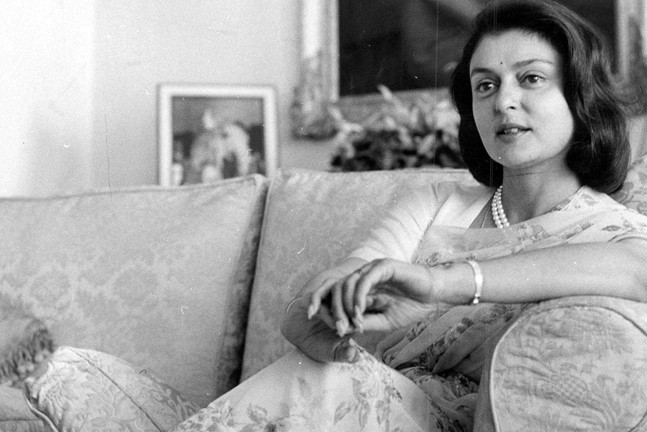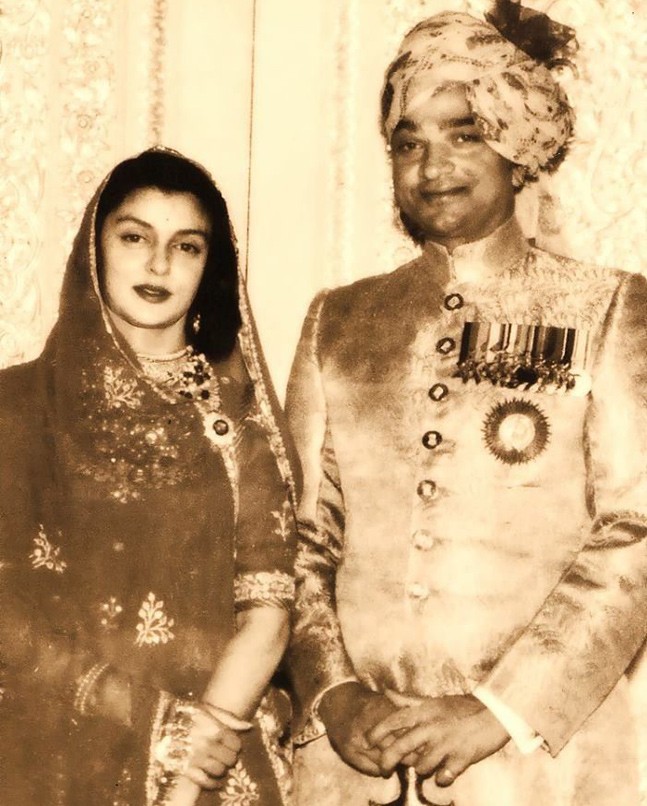Maharani Gayatri Devi
This is a collection of articles archived for the excellence of their content. |
Contents |
Life: 1919-2009






Maharani Gayatri DeviBorn as Princess Gayatri Devi of Cooch Behar, the third Maharani of Jaipur was admired for her charm and beauty and featured in the list of Vogue's 'Ten Most Beautiful Women of the World.'Her most treasured jewels were her wedding diamond chandelier earrings and a navratan necklace strung on a gold chain, given to her by her husband, Maharaja Sawai Man Singh II.
The person
Ananya Bhattacharya, Posted by Samrudhi Ghosh, August 31, 2017: India Today
She was dressed in a turquoise-blue chiffon sari with silver sequins sparkling like stars on a moonless night. She looked around with her large almond eyes. Everyone stood up. As Hillaire Belloc once described someone, 'her face was like the king's command when all the swords are drawn. - The New York Times Magazine, 1966
In 2005, a few years before her death, Maharani Gayatri Devi visited her hometown, Cooch Behar, one last time. She performed a pooja at the local temple, Madan Mohan Bari. The municipality had sprung into action a few months before her visit and 'beautified' the temple complex with artificial palm trees. But the mercurial princess wasn't pleased. She snapped at the people showing her around, "Why are these artificial trees here? They belong in five-star hotels!"
And just as quickly as she lost her temper, she got back to smiling at the hundreds of residents around her. Eight-year-old kids with their parents, 80-year-olds with their families. No one in the town could think of doing anything else that evening. She was about 86 years old at that time. You had to see her to understand what beauty means. No make-up, no frills, a wrinkled face, but what radiance!
The Maharani spent the night at the town's Circuit House and left for Jaipur the next morning. Her home, the Cooch Behar Rajbari, was an ASI monument; inhabitable, but for the guards. She told the people that she would return to Cooch Behar soon. She never did.
In 2009, four years after the last time her hometown saw her, we received the news that the Maharani was no more. The last 'guardian' of the town was gone. She outlived her brother Jagaddipendra Narayan, who died in 1970, and was the last king of Cooch Behar before the kingdom became a part of India. The town came to a standstill. People all over the town mourned their 'Rajmata' for three days. Offices, shops, markets were all shut for those three days. A pall of gloom covered the town. It took several months for the town to cripple back to normalcy. Gayatri Devi was dead. The truth sank in after many days of disbelief.
Gayatri Devi is still that one person who made the country know my little town by its name.
Vogue called her: Vogue called her 'a dream in sari and jewels'
The woman whose beauty cast a spell on the entire world.
EARLY YEARS: 'A DREAM IN SARI AND JEWELS'
Gayatri Devi was born to royalty, to Maharaja Jitendra Narayan and Indira Devi. The kingdom of Cooch Behar, nestled at the foothills of the Himalayas, saw her shooting her first panther at the age of 12. Vogue named her year after year as one of the 10 most beautiful women in the world. She was a 'dream in sari and jewels'. Born to a royal family and married into another, Gayatri Devi grew up surrounded by an unimaginable display of wealth. Her six-year courtship with Maharaja Jai Singh of Jaipur culminated in marriage; her first, his third. He proposed to her in the back seat of a Bentley in London, as the car went around Hyde Park. The third wife of Sawai Man Singh II of Jaipur was not ready to be confined to the regressive purdah, a custom that her two sister-wives followed. She lived in Jaipur till her death in 2009.
RIVALRY WITH INDIRA GANDHI
Gayatri Devi belonged to one of the country's last royal families after the privy purses were abolished. She remained a formidable opponent of the Congress all through her brief political career. It was a relationship fraught with problems and rivalries that dated back to her years in Shantiniketan where she constantly found herself pitted against Indira, then Nehru. The stories about Indira Gandhi's ego problems with Gayatri Devi's beauty and unabashed display of wealth in Vishwa Bharati form part of an urban legend now.
1962 LOK SABHA ELECTIONS
In 1962, Gayatri Devi decided to run for the Parliament as the Swatantrata Party candidate from Jaipur. The Lok Sabha elections that year went into the Guinness Book of World Records. Gayatri Devi won the constituency in the world's largest landslide, winning 192,909 votes out of 250,272 valid votes. The Congress was decimated in Jaipur with its candidate Sharda Devi managing to secure only 35,217 votes. Gayatri Devi was a member of parliament from 1962 to 1975.
THE EMERGENCY AND IMPRISONMENT
The relationship between Gayatri Devi and Indira Gandhi reached a tipping point during the Emergency. 1971 saw the privy purses abolished and Indira Gandhi declared Emergency in 1975. A series of income tax raids all over the country followed, with Gayatri Devi landing up behind bars for undeclared gold and wealth that was recovered from her palace. She spent five months in jail, and hated the Congress till her last breath.
LIFE AFTER EMERGENCY
Gayatri Devi's remaining years saw her retiring from politics and concentrating on her life and women's empowerment in Jaipur. She published her biography, A Princess Remembers, in 1976, authored by Santha Rama Rau. In a desperate bid, the Trinamool Congress named Gayatri Devi as their candidate from Cooch Behar in 1999. By then, the Rajmata had stopped even bothering to respond to anything that she did not have her heart in.
The Princess of Cooch Behar, the Rajmata of Jaipur, died a quiet death in 2009. Surrounded by just the handful of people who belonged to her reclusive inner circle. Remembered by the town she belonged to and the city she helped transform.
Inheritance of her estate
Grandchildren can inherit: HC
Gayatri Devi’s grandchildren can inherit estate: HC, December 11, 2017: The Times of India
The Delhi high court ruled in favour of the two grandchildren of the Rajmata of Jaipur, Gayatri Devi, saying that they are the legal heirs to her property.
Overturning its previous order, which held that two stepsons of the late maharani of Jaipur were also entitled for a share, the HC disposed the plea of the two grandchildren — Devraj Singh and Lalitya Kumari — and said they would inherit the entire estate.
“The present applicants are to be treated as legal representatives of late Gayatri Devi (sic),” held Justice S Ravindra Bhat, paving the resolution of an eightyear-old case, which arose after the legendary queen passed away in 2009.
The death of Gayatri Devi, third wife of Sawai Man Singh-II, had led to a property dispute between the children of her only son Jagat Singh and her stepsons — Prithvi Raj Singh and Jai Singh.
After Devi’s death, the grandchildren asserted that they were “class-I heirs” under the Hindu Succession Act, 1956. They also relied on a will of June 10, 2009 whereby Devi bequeathed her estate to them.
However, the grandchildren’s submissions were countered by Prithvi Raj and Jai Singh, who relied on the will of the late Jagat Singh, which excluded his children from succession to his properties.
Jagat Singh, who was married to Priyanandana Rangsit, a Thailand princess, had disinherited his children after his divorce.
Justice Bhat also relied on a Supreme Court judgment drawing a clear distinction between a child “from the womb” and a stepson. “Therefore, the question of other individuals, claiming to succeed to Gayatri Devi’s will, cannot arise,” it observed.
